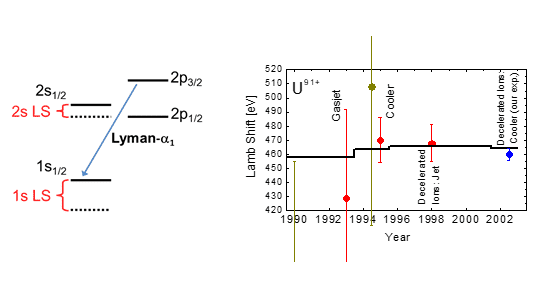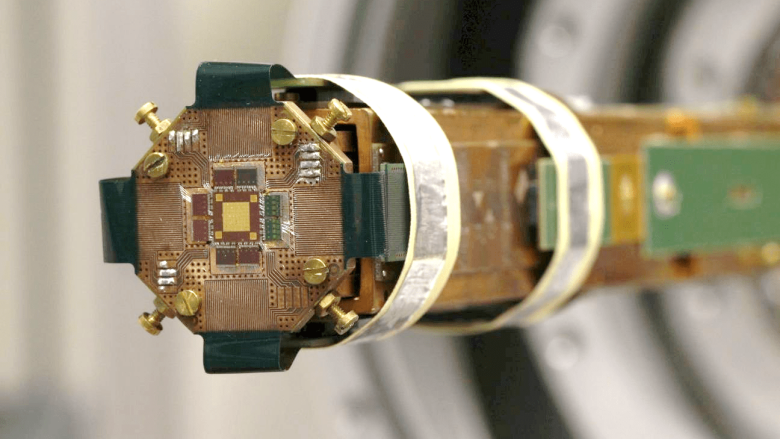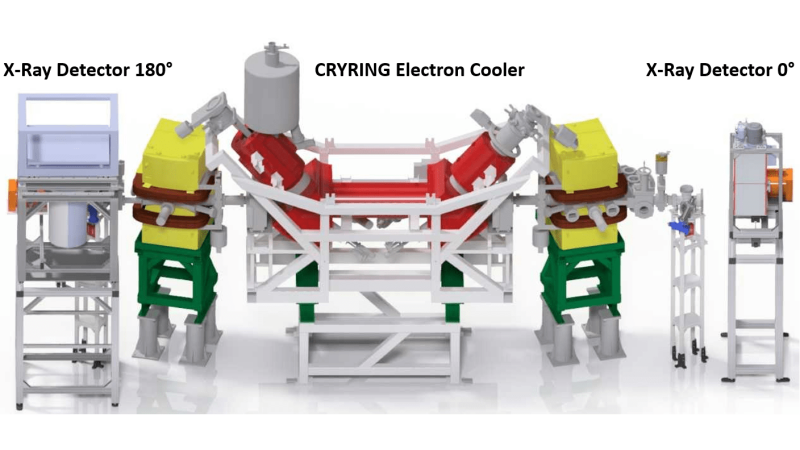Precision X-ray spectroscopy of the Lamb shift
Involved Staff:
M. O. Herdrich1,2, P. Pfäfflein1,2, F. M. Kröger1,2,3, B. Zhu1,2, G. Weber1,2, Th. Stöhlker1,2,3
1Helmholtz Institute JenaExternal link
2GSI Helmholtzzentrum für Schwerionenforschung GmbHExternal link
3Institute of Optics and Quantum Electronics, Friedrich Schiller University Jena
The Lamb shift describes the difference of the observed binding energy in atomic systems from the value predicted by Dirac theory assuming a point-like atomic nucleus with infinite mass. The main goal of the project is the precision measurement of the Lyman-α transitions of H-like uranium (at about 100 keV) in order to determine the Lamb shift of the 1s ground state with an accuracy better than 1 eV. This would make quantum electrodynamic corrections of order α2 accessible to verification for the first time, which represents a key experimental as well as theoretical challenge for the field of strong-field QED of bound states. The experimental approach is based on two technological challenges:
a) first experiment with fully ionized uranium ions at CRYRING@ESRExternal link and there at the ultracold electron cooler; b) first use of high-resolution microcalorimeter detectors in a dedicated experiment. The integration of these detectors into the heterogeneous detector environment of ion storage rings is a key technological challenge that will enable, for example, coincidence measurements. Finally, the project aims to establish the use of microcalorimeter detectors as an enabling technology for future spectroscopy experiments of the SPARC collaboration, with a very broad application in the field of structure and dynamics of highly charged and exotic ions.
Left: Precise measurement of the energy of the Lyman-α₁ transition is useful for determining the Lamb shift of the ground state. Right: Measurements of the 1s Lamb shift in hydrogen-like uranium. With the exception of one data point from BEVALAC in 1990, all measurements were made at GSI's ESR storage ring. The most recent data point was published in 2005. Since then, a major effort has been made to develop an experiment design with which an accuracy
Graphic: Günter Weber-
Micro-calorimeter detectors for x-ray spectroscopy
In recent years, multiple x-ray detector-arrays based on the metallic-magnetic micro-calorimeter-technology (maXs) were developed in collaboration with the group of Prof. C. Enss of the Kirchhoff-Institute for PhysicsExternal link of the university of Heidelberg [1]. Because of their detection principle – absorption of an x-ray photon giving rise to a change in temperature in a paramagnetic sensor – and the operation at temperatures below 50 mK they reach high energy resolutions (E/ΔE > 3500) comparable with crystal spectrometers [2]. At the same time, they cover a broad spectral energy range of typically 100 eV up to 100 keV. These properties make them an ideal measuring instrument for atomic physics, since often the dynamics of atomic processes result in the emission of x-ray photons in a broad spectral range. Among other things, in the past two experiments involving collisions of highly charged heavy ions with a gas target have been successfully performed at the ESR (experiment storage-ring) of the GSI Helmholtzzentrum für Schwerionenforschung in Darmstadt utilizing the new detectors.
References:
[1] D. Hengstler, M. Keller et al., Physica Scripta T166 (2015), DOI:10.1088/0031-8949/2015/T166/014054External link
[2] S. Kempf, A. Ferring et al., Superconductor Science and Technology, vol. 28 (2015), DOI:10.1088/0953-2048/28/4/045008External linkPhoto of the maXs-30 detector mounted to the cold-finger of a dilution cryostat
Image: Kirchhoff-Institut für Physik (Universität Heidelberg)
At the electron cooler of the recently commissioned low-energy storage ring CRYRING@ESR at GSI, Darmstadt, a stored beam of fully ionized uranium ions (U92+) will interact with the electron beam of the cooler, trapping electrons into excited states of the then hydrogen-like uranium. The subsequent transitions to lower levels up to the ground state lead to the emission of, among others, the Lyman-α1 radiation shown above (2p3/2 → 1s1/2) with an energy of about 100 keV. The experimental setup includes one high-resolution microcalorimeter each optimized for this measurement at 0° and 180° relative to the flight direction of the stored ion beam. From the ultra-high vacuum of the storage ring, the detectors located in air are separated by thin beryllium X-ray windows. These allow high transmission down to a few keV photon energy. The simultaneous detection of both the high energy Lyman radiation and the low energy Balmer transitions, which are hardly affected by the Lamb shift, should allow a precise determination of both the Lamb shift and the Doppler shift caused by the velocity of the ions.
3D model of the planned experimental setup for the measurement of the Lamb-shift of the ground state of uranium at CRYRING@ESR
Illustration: Günter Weber

